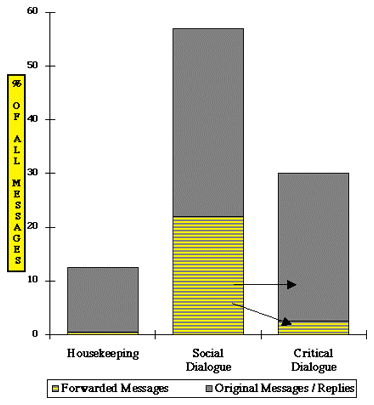

It has been widely believed among experienced Internet users that forwarded messages -- including electronic chain letters, urban legends, Top 10 lists and other jokes, etc. -- constitute a waste of time and bandwidth and, at the least, a distraction from higher-order uses of electronic communication (i.e., critical dialogue). With the widespread use of e-mail by college students, a whole genre of forwarded undergraduate e-mail humor seems to have developed, with titles such as "100 ways to torture your roommate" or "50 things to tell your professor when you turn in your exam." In five years of participating in dorm e-mail lists, I have seen some of the same forwarded messages (or variations on these themes) many times. Other routine forwards have more serious content and include inspirational stories (e.g., about developing friendships or love affairs in college), warnings about date rape or drugs, and political polemics or calls for action. Many messages explicitly advertise their forwarded identity by exhorting the receiver to "send this to all your friends," by including headers from previous senders, or by listing all the colleges and universities where the message has been shared. I think it would be interesting to analyze these evolving genres or subgenres in more detail.
To test the notion that forwarded messages are wasteful distractions in the dorm community context, I classified all 1243 messages to the e-mail list as either forwarded messages or original messages/replies. (In the cases where a forwarded message was framed by the sender's own comments, I made a judgment about whether the primary content was the forwarded material or the original material.) As illustrated in the bar graph, I found that:
I think the usefulness of what has been pejoratively called "junk e-mail" -- and likewise the usefulness of metadiscussion (07) -- for stimulating critical dialogue has been overlooked by other researchers. Rather than wasting bandwidth and distracting people from serious issues, forwarded e-mail messages served as critical discussion prompts that engaged many residents in sustained, thoughtful argumentation.
Moreover, those discussion threads prompted by forwarded messages often spilled over into the face-to-face community. The Rape and Gender thread (15), for example -- along with other gender-related threads -- led our staff to organize additional programs and discussions in the dorm lounge. Those face-to-face discussions, in turn, fed the energy of the ongoing or recurring discussions on the e-mail list. This spiralling effect shows how electronic and traditional media need not be mutually exclusive or in competition but rather can complement each other in promoting community and critical thinking.